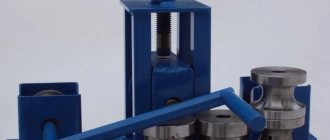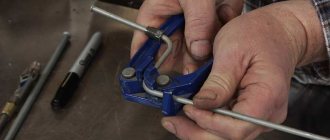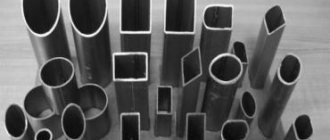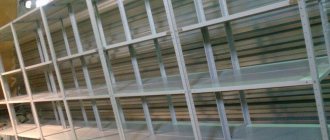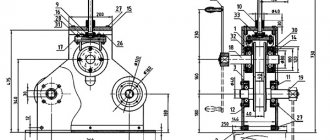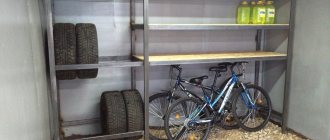When arranging a site or preparing for the dacha season, the need arises for arches made of profile pipes. They are needed when constructing a greenhouse, assembling a gazebo or canopy. It is expensive to buy already bent arches - the price is twice as high as for the same flat rolled products. The solution is to do it yourself, and to make the process easier (it’s very difficult to do by hand) you need to make a pipe bender for the profile pipe. You will need channels or corners, rolling rollers and some other details. Tools include a grinder with a metal disc, a welding machine, and a ruler.
Profile bender design
The machine for bending profile pipes is structurally different from the usual one. This is due, firstly, to the greater resistance of the profile to bending loads, and secondly, to the fact that the bending radius usually required is large. Therefore, the design contains three rollers. Two of them are installed permanently, one remains movable. Using a movable roller, the radius of curvature changes. In general, there are two types of pipe benders for profile pipes: with a middle movable roller and with an outer one (right or left, as desired).
You can make a pipe bender for a profile pipe in different sizes with your own hands
Pipe bender with middle movable roller
The two outermost rollers are fixedly mounted on the body. They are raised above the plane of the base. For the middle roller, a special U-shaped frame is welded. A long, large-diameter clamping screw is installed in the middle of its jumper. A third bead is attached to the lower end of this screw (can be welded). By rotating this screw, the roller lowers and rises, changing the bending radius of the profile pipe.
Design of a pipe bender for a profile pipe with a movable middle roller
A cloud is welded to one of the stationary rollers, with the help of which the pipe is rolled through the machine. To make it possible to apply less effort for rolling, two stationary rollers are connected using a chain. To effectively transmit torque, sprockets are welded to the rollers (possibly from a bicycle), and a chain is selected for them. This simple mechanism makes bending a profile pipe much easier.
With extreme movable roller
In this design, the right or left roller is made movable. It moves along with part of the base. This part is connected to the rest of the frame using powerful metal hinges.
Drawing of a bending machine for profile pipes with a lifting platform
You can change the height using a jack, as shown in the drawing. The height of the platform in this case is selected depending on the height of the jack. The bending radius is changed by lifting the movable part of the table.
Pipe bender for profile pipe with lifting platform
Unlike the previous design, this pipe bender for a profile pipe is driven from the central roller - a handle is welded to it. To reduce the required force, you can also weld the sprocket to two fixed rollers and transmit torque using a chain.
Classification by bending method
Based on the nature of the profile impact, the following types are distinguished:
- Segmental - pulls the workpiece through a series of rollers, each of which has its own effect and changes the geometry.
- Crossbow - its main element is a device that sharply moves forward, bending the fixed rolled product along the required radius.
- Spring - equipped with grips that straighten and bend the structures being held (if they are made of not the most durable material, for example, plastic).
When performing work, say, assembling a frame for a country greenhouse, you should not chase big corners. Remember, the more you deform the part, the more likely it is to break under load.
Well, now let's move on to the features of creating the simplest mechanisms.
What materials and design details are needed?
The base of the pipe bender is made from a channel or two welded angles. The thickness of the shelves is at least 3 mm; select the width of the shelves and the back of the channel to match the existing parts. One rule - the base must be massive and reliable.
Several holes can be made along the edges of the platform. Through them you can fix the machine to some heavy base using large diameter self-tapping screws. Fixation is necessary, since when bending pipes with a thick wall, significant forces have to be applied and it is more convenient to work if the machine is firmly fixed.
This is what the frame looks like with welded racks for attaching the movable roller
A few words about rollers. They must be made of good, high-quality, preferably hardened steel. It is on the rollers and on the axles that hold them that most of the load falls.
It should also be said about the shape of the rollers. They should not be smooth - there should be rollers along the edges that will prevent the pipe from “walking” during rolling. Only under such conditions will the arc from the profile pipe be smooth and not twisted. Ideally, each pipe size needs its own rollers. But then the design becomes more complicated - they need to be made removable, and a reliable method of fastening must be thought out. The second option is to make videos of complex shapes, such as in the photo. Carve several steps for different pipe sizes.
Rollers for bending profile pipes of different widths
In the same photo you can see that the upper part of the bed is not smooth, but toothed. With the help of such teeth, the rollers can be rearranged to different distances and thus also adjust the bending radius.
In general, homemade bending machines for profile pipes are assembled from what is at hand or what they can find/buy inexpensively. Those who have the opportunity grind out the rollers and insert bearings. Those who don’t have such an opportunity use what they have, right down to the bushings from bicycle wheels. In general, you need to understand the design and
Operating rules
When using the mechanism, do not allow it to fall or be struck.- Be sure to protect it from moisture and precipitation.
- During operation, all its rotating elements must be closed or at least located at a safe distance from others.
- Make sure that fingers, clothing, and foreign objects do not get between the shafts.
Do-it-yourself home pipe bender for a profile pipe: photos of self-made models
Tricks to make pipe bending easier
To make the rollers move better, bearings are used. But, in principle, for a homemade pipe bender, which will be used only occasionally, you can simply make holders from a corner or channel. Make a hole in them that is slightly larger in size than the axis on which the roller will be mounted. Pass the axle with the roller on through the holes of the holders and somehow fix them (at least weld on a couple of points that will be stoppers). During operation, for better performance, lubricate the rubbing areas with a thick lubricant such as Litol. This is not suitable for industrial and semi-industrial production, but it’s just right for making arcs for a greenhouse or gazebo with your own hands.
Example of turned beads
There is one more trick that helps reduce the required force when bending a profile pipe. You can use the principle of increasing gears as in a bicycle. By the way, you can use bicycle sprockets. In this case, the handle that drives the rollers is welded to a small star. It is installed somewhere on the body. Larger sprockets are welded onto the shaft axis (but teeth with the same pitch). All this is connected by a suitable chain.
With such a torque transmission device, an electric drive is not needed - it will be easy to work
And one more improvement - if you constantly use a pipe bender for a profile pipe, it makes sense to mechanize it. In this case, they install a motor that operates at low speeds.
Character traits
At its core, this is a mechanical device (installation) that bends a straight profile to the desired radius, from 1 to 180 degrees. Suitable for both metal (aluminium, steel) and plastic elements.
Factory equipment is standard, but it assumes you have experience with it. Therefore, it’s worth making a pipe bender for a professional pipe with your own hands, if only because you don’t have to get used to it. You will know exactly all the features of its design and understand what loads its elements will withstand.
The procedure for bending a profile pipe on homemade machines
It is unlikely that you will be able to obtain the required bending radius in one go - too much force is required for this. It is impossible to create it manually. Receive the required bend in several passes:
- First, the rollers are aligned so as to obtain a slight bend, the pipe is rolled in one direction, then removed from the rolls, unfolded and inserted on the other side. It is necessary to unfold in order to obtain an evenly curved pipe.
- With the same position of the rollers, it is pulled several times until the curvature is no longer added.
- If the required bending radius is not achieved, change the position of the roller and repeat the steps again.
Rolling pipe bender with electric drive
The change in bending radius is achieved gradually, otherwise you won’t be able to make an arc from a profile pipe on a homemade pipe bender. What to do if you need to repeat the same bend? Make a graduation - note to what height the roller moved, how many times it was rolled in each position. When repeated, the differences, if any, will be insignificant.
The difficulty of bending lies in the fact that there is no scale and it is difficult to obtain the intended bending radius without experience. Sooner or later you will get it, but you can spoil a lot of material in the process.
Device options
If you make it yourself, your hands are free. For example, nothing prevents you from implementing a lever-type installation so that the force is concentrated at a certain point, making it easier to ensure the desired radius of curvature. This configuration allows you to create templates that can be easily removed and replaced with others. Let there be 2–3 of them - for rolled products of different diameters.
The mechanism can also be crossbow or drone, that is, as compact as possible, designed for short sections of pipes. It will be very convenient during installation, when laying communications, in confined spaces.
How to bend a profile pipe without a machine
There are two ways to make an arc from a profile pipe without a profile bender - using welding and a template. Let's start with welding.
Get an arc by welding
The profile pipe is cut with a grinder on one side. They are made every 15-30 cm, depending on the required radius, cross-section and wall thickness. The cuts should not touch one side - the one that will be on the outside.
Result of bending by welding
The spare part prepared in this way is bent, giving the desired bend. For reliability, the edges of the arc can be fixed by welding a rod to them. Then welding is carried out along all the cuts, welding them. And the last stage is grinding the weld spots and treating them with anti-corrosion compounds.
Using a template
Thin-walled profiled pipes can be bent by hand using templates. If you need a special shape, it can be cut out of a piece of thick plywood or chipboard and secured to the table using clamps. On the workbench where we will bend the pipes, make about 8-10 holes. The template is placed near these holes.
The process of obtaining an arc from a profile pipe using a template
The holes are repeated at one end of the pipe; with their help, the pipe is attached to the workbench. Now the free end of the pipe begins to be pulled smoothly, forming a bend that follows the shape. You need to pull smoothly, without jerking.
The template can also be made on the ground. Pipes-pegs are driven into the ground (at least half a meter deep). They form the required arc. For emphasis, two additional stakes are driven in, which are located to the side of the arc. The distance you need to step aside is slightly greater than the width of the pipe.
Pattern on the ground
Having inserted the pipe, it is pulled towards the arc. Great efforts are required, the work is hard. This can only be achieved with a thin-walled, seamless pipe. The suture has too much resistance in the seam area. It is very difficult to overcome it manually.
Classification by drive type
The motor is equipped with quite powerful models, which, in the factory version, are actively used in production. But such equipment can also be assembled personally (based on drawings and diagrams) for subsequent use in a home workshop. Essentially, you will get a machine that looks like this:
- Hydraulic – stationary, powerful, designed for diameters from 3 inches. It is best suited for industrial facilities, as it allows for large-scale work to be carried out with a high degree of productivity.
- Electromechanical is a good choice for bending main elements. It is convenient because it can be used to calculate with maximum accuracy both the optimal clamping force and the required angle.
- Manual – focused on small sections and low intensity of use.
Why do you need a pipe bender?
A hundred years ago, houses were built from adobe and clay. Nowadays, most buildings are created from light metal frames. Many gazebos, almost all fences, and extensions require metal profile pipes.
Homemade pipe bender
But in construction, not all objects should be angular and smooth. Sometimes, to achieve special comfort, you have to make smooth curves. It is in such cases that a homemade pipe bender comes in handy.


